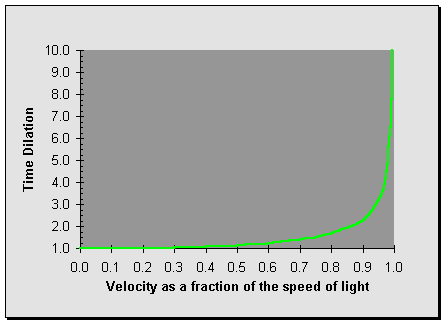
Time Dilation
It turns out that as an object moves with relativistic speeds a "strange" thing seems to happen to its time as observed by "us" the stationary observer (observer in an inertial reference frame). What we see happen is that the "clock" in motion slows down according to our clock, therefore we read two different times. Which time is correct??? well they both are because time is not absolute but is relative, it depends on the reference frame. Let's look at the following classic example. There is a set of twins, one an astronaut, the other works for mission control of NASA. The astronaut leaves on a deep space trip traveling at 95% the speed of light. Upon returning the astronauts clock has measured ten years, so yhe astronaut has aged 10 years. However, when the astronaut reunites with his earth bound twin, the astronauthe sees that the twin has aged 32 years! This is explained due to the fact that the astronaut's twin is traveling at relativistic speeds and therefore his "clock" is slowed down.
Let's see how we can calculate the time "difference". The equation for calculating time dilation is as follows:
t = t0/(1-v2/c2)1/2
where: t = time observed in the other reference frame
t0 = time in observers own frame of reference (rest time)
v = the speed of the moving object
c = the speed of light in a vacuum
so in our problem we will let v = .95c, t0 = 10 years and we will solve for t which is the time that the earth bound brother measures.
t = 10/(1- (.95c)2/c2)1/2
t = 10/(1- .952)1/2
t = 10/ .312
t = 32 years
(the time the earth bound brother measures)
Now let's have a closer look at the equation and determine just what impact the speed of the object has on time dilation. We can see that is the velocity is small compared to the speed of light the quantity v2/c2 approaches 0 and the equation simplifies t0: t = t0/1 which is simply t. So at relatively slow speeds (our everyday speeds) time dilation is not a factor and Newton's Laws are still applicable. Now let's look at high speeds (close to the speed of light), from the equation that as velocity increases the quantity v2/c2 approaches 1 (but will never quit reach it), causing the quantity(1-v2/c2)1/2 t0 become smaller and smaller....therefore causing the time measured by the other observer t0 become greater thus making our time appear slower (refer back to the example). I know its so confusing!!! read it again, think about it, then study the graph below. As one can see in the graph time dilation starts t0 "show up" between .4c and .5c. Also notice that the closer one gets to the speed of light the greater impact speed has on time dilation (notice how steep the curve gets towards the end)..

home | special relativity | length contraction | mass changes